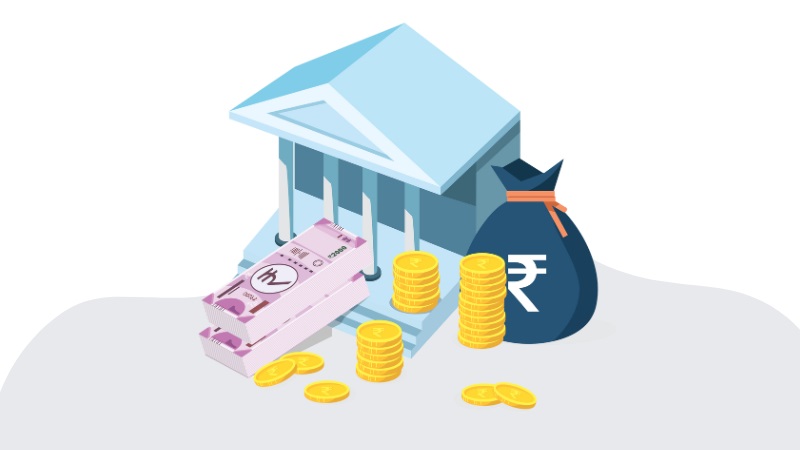CRR stands for Cash Reserve Ratio, and it is the percentage of total deposits in a bank that have to be kept in cash to operate risk-free. The RBI decides the CRR, and it is the amount of funds that is parked with the central bank to mitigate the liquidity crisis of banks. The bank cannot use this amount for lending, neither they get an interest from the RBI. In this article, we have discussed CRR, CRR full form, and its impact on Indian banking.
What is the Cash Reserve Ratio?
CRR, or “Cash Reserve Ratio,” is a fundamental banking tool that signifies the percentage of a bank’s total deposits that can be held in cash or deposited with the central bank. This regulatory measure serves as a financial safeguard, ensuring that banks maintain a reserve to cover potential withdrawals, contributing to overall financial stability and prudent banking practices.
In the Indian context, CRR emerges as a cornerstone of monetary policy orchestrated by the Reserve Bank of India. As a dynamic tool, CRR adjustments allow the RBI to manage money supply, control inflation, and steer economic conditions. By influencing liquidity in the banking system, CRR becomes integral to achieving monetary policy objectives, ensuring the stability of the financial sector, and fostering sustainable economic growth.
The full form of CRR is Cash Reserve Ratio, and it sets aside a specific portion of the deposits as a reserve. The ratio is determined by the RBI and it serves as a mechanism to mitigate risks for unforeseen challenges thus instilling confidence in the financial system.
Get Personal Loans upto ₹10 lacs
Starting at 10.5% per annum*
How Does the Cash Reserve Ratio Function?
The mechanism of CRR involves the breakdown of a bank’s total deposits while holding a specific percentage to be held as reserves. The commercial banks deposit these funds with the central bank, ensuring financial stability by providing a cushion against unforeseen withdrawals and allowing central banks to influence the money supply by adjusting the CRR percentage. It offers a systematic approach to balancing liquidity and credit creation within the banking system.
The CRR plays a pivotal role in maintaining a bank’s liquidity and stability. This acts as a financial buffer for the bank against liquidity crisis, thus minimising the risk of the bank. These regulatory measures foster stability within the financial system within the financial system. The impact of CRR prevents excessive lending thus promoting a resilient banking sector thus contributing to overall financial stability and the well-being of the banking industry.
Why is it important for a bank to maintain a cash reserve ratio (CRR)?
Maintaining a Cash Reserve Ratio (CRR) is crucial for banks as it ensures financial stability, acts as a regulatory tool, and supports effective monetary policy. CRR safeguards against liquidity crises, providing a buffer for unexpected withdrawals.
Regulatory compliance with CRR reduces risks and fosters a resilient banking sector to manage the money supply and control inflation.
What is the current CRR rate in India? (2024)
The current CRR rate in India is 4.5%.
Current CRR in India and Its Role in the Economy
The Reserve Bank of India has prescribed of the current CRR value. This is an important tool of the monetary policy of India as it influences the liquidity and credit facility. The changes in CRR are implemented by RBI to control inflation and maintain financial stability.
The Cash Reserve Ratio (CRR) influences the economic indicators by regulating the money supply. An increase in the CRR value curbs inflation, but slows down economic growth. While a decrease in the CRR fosters economic activity while reducing inflation. Adjusting CRR impacts the interest rates affecting investment.
For instance, if an individual deposits or invests Rs 20,000 in a commercial bank, then the deposit of that bank will increase by Rs 20,000. Whereas, if the CRR is 12%, then the bank will hold an extra Rs 2,400 with RBI, and the commercial bank will be entitled to use only Rs 17,600 for investments.
| Also, read: What is the Statutory Liquidity Ratio (SLR)? |
The Direct Correlation: CRR and Lending Rates
The CRR and lending rates share a direct correlation that works on a country’s monetary policy. When the CRR values are high, the banks have to set aside a portion of the deposit as reserves with the RBI. Whereas, the reduction in the available funds then it can lead to high lending rates thus making borrowing expensive. Conversely, a lower CRR allows banks to increase lending, potentially resulting in lower interest rates to encourage borrowing.
Why is the Cash Reserve Ratio (CRR) important for banks?
- CRR helps in managing liquidity in the banking system. By requiring banks to hold a certain percentage of their deposits as reserves with the central bank, it ensures that a portion of funds is not available for lending, helping control excess liquidity.
- CRR is a tool used by central banks to implement monetary policy. The adjustments in CRR influence the money supply impacting inflation and economic growth. It allows central banks to regulate credit expansion or contraction in the economy.
- CRR serves as a tool to ensure the overall health and resilience of the banking sector. The bank’s requirement to maintain reserves reduces excessive risk-taking and promotes a stable financial space.
- CRR influences interest rates by affecting the amount of funds available for lending. Higher CRR tightens liquidity, potentially leading to higher interest rates, while lower CRR can result in lower interest rates to stimulate borrowing.
How does the Cash Reserve Ratio (CRR) impact depositors?
The Cash Reserve Ratio affects the depositors by influencing the bank’s lending capacity and deposit interest rates. When the CRR is increased, the banks are required to hold a higher portion of deposits as reserves, thus limiting their ability to lend. The reason for this is that it reduces the interest rates on deposits, thus affecting the overall earnings. Conversely, a lower CRR allows the banks to lend more, thus leading to high deposit interest rates.
Cash Reserve Ratio Formula
One can calculate the Cash Reserve Ratio by using the formula prescribed in the space below.
CRR = Total Demand and Time Deposits in the Banking System / Total Reserves held by Commercial Banks at the Central Bank × 100
In this formula:
- CRR represents the Cash Reserve Ratio,
- “Total Reserves held by Commercial Banks at the Central Bank” refers to the total amount of reserves that commercial banks are required to maintain with the central bank.
- “Total Demand and Time Deposits in the Banking System” represents the sum of demand deposits and time deposits held by commercial banks.
The result is multiplied by 100 to express the CRR as a percentage. This ratio is a key monetary policy tool used by central banks to regulate liquidity in the banking system.
How to Calculate the Cash Reserve Ratio (CRR)?
To calculate the Cash Reserve Ratio (CRR), you would use the following formula:
CRR = Total Demand and Time Deposits in the Banking System / Total Reserves held by Commercial Banks at the Central Bank × 100
Here’s a step-by-step guide to calculate CRR:
- Determine Total Reserves held by Commercial Banks at the Central Bank.
- This includes the total amount of reserves that commercial banks are required to maintain with the central bank. It typically consists of a percentage of their total deposits.
- Determine Total Demand and Time Deposits in the Banking System.
- Add up the total demand deposits (checking accounts) and time deposits (savings accounts, fixed deposits, etc.) held by commercial banks in the banking system.
- Apply the Formula.
Substitute the values into the CRR formula:
CRR = Total Demand and Time Deposits in the Banking System / Total Reserves held by Commercial Banks at the Central Bank × 100
Calculate and Interpret:
Perform the calculation to get the CRR percentage. This percentage represents the proportion of total deposits that commercial banks are required to hold as reserves with the central bank.
Controlling the Commercial Banks: RBI’s Use of CRR
- Adjusting the CRR allows the RBI to regulate the liquidity in the banking system. A higher CRR drains excess funds, reducing liquidity and curbing inflationary pressures.
- The CRR and the RBI can influence the money supply. Increasing CRR tightens credit availability, helping control inflation by reducing spending and demand.
- Maintaining an optimal CRR ensures the financial system’s stability preventing excessive lending and curbing speculation. This helps to avoid financial imbalances.
- CRR acts as a tool for adjusting the monetary policy. Changes in CRR impact banks’ lending capacity, affecting interest rates and overall credit conditions in the economy.
- CRR serves as a macroprudential tool, safeguarding the financial system against systemic risks. These deposits can be held as reserves, thus increasing the resilience of the banking sector and mitigating the risk of a financial crisis.
The Symbiotic Relationship Between CRR and Interest Rates
The Cash Reserve Ratio (CRR) and interest rates share a symbiotic relationship within a country’s monetary policy. The Reserve Bank of India sets the CRR and asks the commercial bank to hold its deposits as reserves. This influences the overall money supply in the economy. When the CRR rate is high, banks have less to lend, tightening liquidity and potentially raising interest rates. Conversely, a lower CRR boosts available funds, potentially lowering interest rates to stimulate borrowing and economic activity.
The Impact of Interest Rate Fluctuations on CRR
The fluctuations of the interest rate depend on the changes in the Cash Reserve Ratio (CRR) dynamics. When the interest rate increases, the borrowing cost rises, thus reducing the demand for loans. While, the reduction in the CRR elevates borrowing, thus increasing the demand for loans and maintaining financial stability. This relationship between CRR and interest rates affects the monetary policy, liquidity, and economic stability.
Conclusion
On a final note, CRR is one of the prominent tools that are used by the central bank to control inflation and liquidity in the country. Considered one of the safest options for banks to park their funds, it helps the banks during liquidity crises.
FAQs
How does CRR and SLR impact the banking industry?
Ans: CRR rate helps to regulate liquidity while SLR impacts the credit growth in the banking industry.
How does the cash reserve ratio CRR affect the lending capacity of banks?
Ans: The increase in the CRR impacts the interest rates of loans directly thus leading to an increase in the overall interest rate.
What is the effect of cash reserve ratio CRR on credit creation by commercial banks?
Ans: An increase in the CRR rate means that the banks have to retain a large portion of the cash in the form of deposits with the central bank.
What is CRR in banking?
Ans: CRR in banking stands for Cash Reserve Ration.
What is the CRR ratio in India in 2024?
Ans: The current rate of CRR in India 2024 is 4.5%.
Explore PayMe’s Products:




